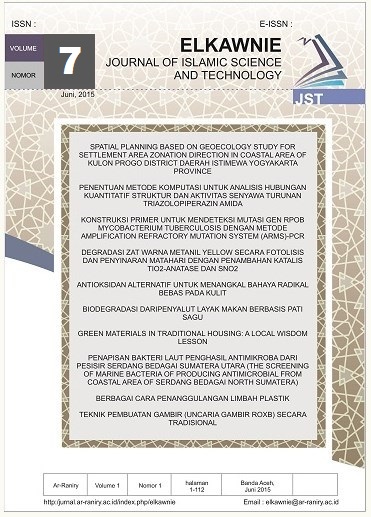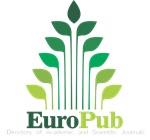Isolation and Cytotoxic Activity of The β-Carotene Combination of Trigona Honey and Namnam Leaves Extract (Cynometra cauliflora)
DOI:
https://doi.org/10.22373/ekw.v7i1.8696Keywords:
β-carotene, BSLT, cytotoxic, Namnam leaves extract (Cynometra cauliflora), Trigona honeyAbstract
Abstract: Isolation and cytotoxic activity of the β-carotene combination of Trigona honey and Namnam leaves extract (Cynometra cauliflora) were conducted. The urgency of isolating β-carotene compounds because of their known anticancer activity. Namnam leaves are macerated using methanol, then combined with Trigona honey. Fractionation and isolation of β-carotene in combination samples were conducted out by chromatography method. The β-carotene was analyzed using UV-Vis and FTIR spectrophotometer. The cytotoxic activity test was conducted by using the Brine Shrimp Lethality Test (BSLT) method with mortality analysis using Probit Analysis with SPSS v20 and Lethal Concentration 50 (LC50) as parameters. The result showed that the cytotoxic activity of Trigona honey after combination reached 36.6% with an LC50 value of 168.2 ppm, an increase from the Trigona honey sample (LC50 = 265.2 ppm) and Namnam leaves extract (LC50 = 196.12 ppm). The highest cytotoxic activity belongs to the n-hexane fraction (LC50 = 77.6 ppm). The best eluent for β-carotene isolation is petroleum ether. There was increased cytotoxic activity in isolates (LC50 of 22.85 ppm). Isolates were analyzed by UV-Vis and FTIR and compared with standards compound. FTIR analysis results showed that the isolates had functional groups of -CH3 (v 2850-2960 cm-1), -CH3 aliphatic (v 1350-1470 cm-1), C=C (v 2100-2350 cm-1 and 675-870 cm-1), and C-O (v 1000-1300 cm-1). Thus, the combination of Trigona Honey and Namnam leaf extract can be developed as an alternative chemopreventive agent.
Abstrak: Isolasi dan aktivitas sitotoksik β-karoten kombinasi madu trigona dan ekstrak daun namnam (Cynometra cauliflora) telah dilakukan. Urgensi mengisolasi senyawa β-karoten karena telah diketahui adanya aktifitas antikanker. Daun namnam dimaserasi menggunakan metanol, untuk kemudian dikombinasikan dengan madu trigona. Fraksinasi dan isolasi β-karoten pada sampel kombinasi dilakukan dengan metode kromatografi. Kandungan senyawa β-karoten dianalisis menggunakan spektrofotometer UV-Vis dan FTIR. Uji aktifitas sitotoksik dilakukan dengan metode Brine Shrimp Lethality Test (BSLT) dengan analisis mortalitas menggunakan Probit Analysis dengan software SPSS v20 dan Lethal Concentration 50 (LC50) sebagai parameter. Hasil analisis menunjukkan bahwa aktivitas sitotoksik madu trigona setelah dikombinasikan mencapai 36,6 % dengan nilai LC50 sebesar 168,2 ppm, meningkat dari sampel madu trigona dengan (LC50 = 265,2 ppm), dan ekstrak daun namnam dengan (LC50 = 196,12 ppm). Aktifitas sitotoksik tertinggi dimiliki oleh fraksi n-heksana(LC50 = 77,6 ppm). Eluen terbaik untuk isolasi β-karoten adalah petroleum eter. Terjadi peningkatan aktifitas sitotoksik pada isolat hasil pemisahan (LC50 sebesar 22,85 ppm). Isolatdianalisis dengan UV-Vis dan FTIR dan dibandingkan dengan senyawa standar. Hasil analisa FTIR menunjukkan isolat memiliki gugus fungsi -CH3 (v 2850-2960 cm-1), -CH3 alifatik (v 1350-1470 cm-1), C=C (v 2100-2350 cm-1 dan 675-870 cm-1), dan C-O (v 1000-1300 cm-1). Dengan demikian, kombinasi Madu Trigona dan ekstrak daun namnam berpotensi untuk dikembangkan sebagai agen kemoprefentif alternatif.
References
Afrin, S., Haneefa, S. M., Fernandez-Cabezudo, M. J., Giampieri, F., Al-Ramadi, B. K., & Battino, M. (2020). Therapeutic and preventive properties of honey and its bioactive compounds in cancer: An evidence-based review. Nutrition Research Reviews, 33(1), 50–76. https://doi.org/10.1017/S0954422419000192
Al-Waili, N. S. (2005). Mixture of honey, beeswax and olive oil inhibits growth of Staphylococcus aureus and Candida albicans. Archives of Medical Research, 36(1), 10–13. https://doi.org/10.1016/j.arcmed.2004.10.002
Biswas, A. K., Sahoo, J., & Chatli, M. K. (2011). A simple UV-Vis spectrophotometric method for determination of β-carotene content in raw carrot, sweet potato and supplemented chicken meat nuggets. LWT - Food Science and Technology, 44(8), 1809–1813. https://doi.org/10.1016/j.lwt.2011.03.017
Bolhassani, A., Khavari, A., & Bathaie, S. Z. (2014). Saffron and natural carotenoids: Biochemical activities and anti-tumor effects. Biochimica et Biophysica Acta - Reviews on Cancer, 1845(1), 20–30. https://doi.org/10.1016/j.bbcan.2013.11.001
Bray, F., Ferlay, J., Soerjomataram, I., Siegel, R. L., Torre, L. A., & Jemal, A. (2018). Global cancer statistics 2018: GLOBOCAN estimates of incidence and mortality worldwide for 36 cancers in 185 countries. CA: A Cancer Journal for Clinicians, 68(6), 394–424. https://doi.org/10.3322/caac.21492
Britton, G., Jensen, S. L., & Pfender, H. (2004). Carotenoids (1st ed.; A. Z. Mercadante & E. S. Egeland, Eds.). https://doi.org/10.1007/978-3-0348-7836-4
Britton, G., Liaaen-Jensen, S., & Pfander, H. (1995a). Carotenoids Volume IA : Isolatioan and Analysis. Berlin: Birkhauser Verlag.
Britton, G., Liaaen-Jensen, S., & Pfander, H. (1995b). Carrotenoids Volume IB : Spectroscopy. Berlin: Birkhauser Verlag.
Dos Santos, A. F., De Almeida, D. R. Q., Terra, L. F., Baptista, M. S., & Labriola, L. (2019). Photodynamic therapy in cancer treatment - an update review. Journal of Cancer Metastasis and Treatment, 5(25). https://doi.org/10.20517/2394-4722.2018.83
Ferreira, I. C. F. R., Aires, E., Barreira, J. C. M., & Estevinho, L. M. (2009). Antioxidant activity of Portuguese honey samples: Different contributions of the entire honey and phenolic extract. Food Chemistry, 114(4), 1438–1443. https://doi.org/10.1016/j.foodchem.2008.11.028
Harrison, E. H. (2012). Mechanisms involved in the intestinal absorption of dietary vitamin A and provitamin A carotenoids. Biochim Biophys Acta, 1821(1), 1–7. https://doi.org/10.1016/j.bbalip.2011.06.002.Mechanisms
Hassan, F., Mohammed, G., El-Hiti, G. A., Alshanon, A., & Yousif, E. (2018). Cytotoxic effects of tamoxifen in breast cancer cells. Journal of Unexplored Medical Data, 3(2), 3. https://doi.org/10.20517/2572-8180.2017.25
Jayappriyan, K. R., Rajkumar, R., Venkatakrishnan, V., Nagaraj, S., & Rengasamy, R. (2013). In vitro anticancer activity of natural β-carotene from Dunaliella salina EU5891199 in PC-3 cells. Biomedicine and Preventive Nutrition, 3(2), 99–105. https://doi.org/10.1016/j.bionut.2012.08.003
Kassim, M., Achoui, M., Mustafa, M. R., Mohd, M. A., & Yusoff, K. M. (2010). Ellagic acid, phenolic acids, and flavonoids in Malaysian honey extracts demonstrate in vitro anti-inflammatory activity. Nutrition Research, 30(9), 650–659. https://doi.org/10.1016/j.nutres.2010.08.008
Kim, Y. S., Gong, X., Rubin, L. P., Choi, S. W., & Kim, Y. (2019). β-Carotene 15,15′-oxygenase inhibits cancer cell stemness and metastasis by regulating differentiation-related miRNAs in human neuroblastoma. Journal of Nutritional Biochemistry, 69, 31–43. https://doi.org/10.1016/j.jnutbio.2019.03.010
Kopustinskiene, D. M., Jakstas, V., Savickas, A., & Bernatoniene, J. (2020). Flavonoids as anticancer agents. Nutrients, 12(2), 1–25. https://doi.org/10.3390/nu12020457
LPMQ. (2021). Q.S. An Nahl. Retrieved January 10, 2021, from Kementerian Agama RI website: https://quran.kemenag.go.id/sura/16
McLoone, P., Warnock, M., & Fyfe, L. (2016). Honey: A realistic antimicrobial for disorders of the skin. Journal of Microbiology, Immunology and Infection, 49(2), 161–167. https://doi.org/10.1016/j.jmii.2015.01.009
Meyer, B. N., Ferrigni, N. R., Putnam, J. E., Jacobsen, L. B., Nichols, D. E., & McLaughlin, J. L. (1982). Brine shrimp: A convenient general bioassay for active plant constituents. Planta Medica, 45(1), 31–34. https://doi.org/10.1055/s-2007-971236
Mezzomo, N., & Ferreira, S. R. S. (2016). Carotenoids functionality, sources, and processing by supercritical technology: A review. Journal of Chemistry, 2016. https://doi.org/10.1155/2016/3164312
Mount Elizabeth Hospital. (2021). Pengobatan Kanker. Retrieved January 10, 2021, from Parkway Holdings Limited website: https://www.mountelizabeth.com.sg/id/facilities-services/centre-excellence/cancer/cancer-treatment#:~:text=3 cara yang umum dilakukan,jumlah sel kanker pada tubuh.
Mukherjee, B., MK, G., & CM, H. (2011). Anticancer Potential of Vitamin A and Beta-Carotene: Mechanistic Approach. NSHM Journal of Pharmacy and Helathcare Management, 2(Februari (2011)), 1–12.
Mungai, Z.M., Nawiri, M.P, and Nyambaka, H. N. (2017). Coconut Oil and Unadulterated Honey. Food Research, 1(October), 170–175.
Patel, R. V., Thaker, V. T., & Patel, V. K. (2011). Antimicrobial activity of ginger and honey on isolates of extracted carious teeth during orthodontic treatment. Asian Pacific Journal of Tropical Biomedicine, 1(SUPPL. 1), S58–S61. https://doi.org/10.1016/S2221-1691(11)60124-X
Rita, W. S., Suirta, I., & Sabikin, A. (2008). Isolasi dan Identifikasi Senyawa yang Berpotensi Sebagai Antitumor pada Daging Buah Pare (Momordica charantia L.). Jurnal Kimia, 2(1), 1–6.
Riyanti, Rahmawati, M., Hidayati, N. V., Syakti, A. D., & Radjasa, O. K. (2018). Analysis of Carotenoids and Identification of Mangrove Sediment Bacteria of. Indonesian Journal of Marine Sciences, 23(4), 163–170. https://doi.org/10.14710/ik.ijms.23.4.163-170
Samarghandian, S., Farkhondeh, T., & Samini, F. (2017). Honey and health: A review of recent clinical research. Pharmacognosy Research, 9(2), 121–127. https://doi.org/10.4103/0974-8490.204647
Singh, P., Baranwal, M., & Reddy, S. M. (2016). Antioxidant and cytotoxic activity of carotenes produced by Dunaliella salina under stress. Pharmaceutical Biology, 54(10), 2269–2275. https://doi.org/10.3109/13880209.2016.1153660
Strapáč, I., Baranová, M., Smrčová, M., & Bedlovičová, Z. (2016). Antioxidant Activity of Honey Mushrooms (Armillaria mellea). Folia Veterinaria, 60(4), 37–41. https://doi.org/10.1515/fv-2016-0036
Sumarlin, L. O., Muawanah, A., Afandi, F. R., & Adawiah. (2019). Inhibitory Activity of HEp-2 Cells by Honey from Indonesia. Jurnal Kimia Sains Dan Aplikasi, 22(6), 317–325. https://doi.org/https://doi.org/10.14710/jksa.22.6.317-325
Sumarlin, L. O., Muawanah, A., & Wardhani, P. (2014). Aktivitas Antikanker dan Antioksidan Madu di Pasaran Lokal Indonesia ( Anticancer and Antioxidant Activity of Honey in the Market Local Indonesia ). Jurnal Ilmu Pertanian Indonesia, 19(3), 136–144.
Sumarlin, L. O., Suprayogi, A., Rahminiwati, M., Tjachja, A., & Sukandar, D. (2015). Bioaktivitas Ekstrak Metanol Daun Namnam Serta Kombinasinya Dengan Madu Trigona. Jurnal Teknologi Dan Industri Pangan, 26(2), 144–154. https://doi.org/10.6066/jtip.2015.26.2.144
Tajudin, T. J. S. A., Mat, N., Siti-Aishah, A. B., Yusran, A. A. M., Alwi, A., & Ali, A. M. (2012). Cytotoxicity, antiproliferative effects, and apoptosis induction of methanolic extract of cynometra cauliflora linn. Whole fruit on human promyelocytic leukemia HL-60 cells. Evidence-Based Complementary and Alternative Medicine, 2012. https://doi.org/10.1155/2012/127373
Tanaka, T., Shnimizu, M., & Moriwaki, H. (2012). Cancer chemoprevention by carotenoids. Molecules, 17(3), 3202–3242. https://doi.org/10.3390/molecules17033202
Zhang, X., Zhao, W. E., Hu, L., Zhao, L., & Huang, J. (2011). Carotenoids inhibit proliferation and regulate expression of peroxisome proliferators-activated receptor gamma (PPARγ) in K562 cancer cells. Archives of Biochemistry and Biophysics, 512(1), 96–106. https://doi.org/10.1016/j.abb.2011.05.004
Downloads
Published
Issue
Section
License
Proposed Policy for Journals That Offer Open Access Authors who publish with the Elkawnie journal agree to the following terms:
a. Authors retain copyright and grant the journal right of first publication with the work simultaneously licensed under a Creative Commons Attribution License that allows others to share the work with an acknowledgement of the work's authorship and initial publication in this journal.
b. Authors are able to enter into separate, additional contractual arrangements for the non-exclusive distribution of the journal's published version of the work (e.g., post it to an institutional repository or publish it in a book), with an acknowledgement of its initial publication in this journal.
c. Authors are permitted and encouraged to post their work online (e.g., in institutional repositories or on their website) prior to and during the submission process, as it can lead to productive exchanges, as well as earlier and greater citation of published work (see The Effect of Open Access).

























